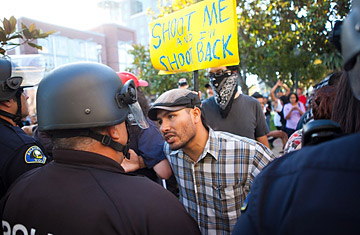
Protesters clash with police during a demonstration to show outrage for the shooting death of Manuel Angel Diaz, 25, at Anaheim City Hall on July 24, 2012 in Anaheim, California.
The city of Anaheim is best known as the home of the Angels baseball team, the Ducks professional hockey team and Disneyland, the "happiest place on Earth." But on Tuesday, only four miles away from Mickey, Minnie and Peter Pan, hundreds of angry protesters swarmed the streets of downtown holding signs that read "Stop Killer Cops" and "They Smell like Pigs." Outside a city council meeting at City Hall, demonstrators threw rocks, started fires, spray-painted walls of businesses and shattered storefront windows. Police in riot gear responded with pepper balls and beanbag pellets. In the evening, a journalist was struck with a rock while other reporters tweeted that they were ducking between cars to avoid non-lethal projectiles fired by police.
It was the fourth day of protests in the city following the fatal shootings of two Hispanic men by police officers over the weekend. Residents are livid at the officers' use of lethal force; and the tension has exposed a rift not only between the haves and have nots, but also between police and the city's large Latino community. "I'm furious. I'm mad," 19-year-old Gaby Pea said at Tuesday's protest. "This is a racial issue. They're unjustly killing Latinos."
The chaos began on Saturday afternoon when an officer fatally shot 25-year-old Manuel Diaz, who was unarmed, as he attempted to flee from police. Family members and neighbors claim he was first shot in the back, fell to his knees, and was then shot in the back of the head. Video by a bystander shows officers walking around Diaz as he lay face down in the grass with his arms handcuffed behind his back. Police have so far declined to detail the reasons for the shooting, only alleging that Diaz was a known gang member.
Hours later, angry residents took to the street and were met with pepper spray and bean bags. A video shot by a local news camera showed officers pointing projectile rifles at crowds that included women and children and a police dog rushing toward a woman and her child. "There were a lot of little kids there when they started to shoot," says Maria Gonzalez, 35, who watched police break up the protest. "They're abusing their authority." Later that night, demonstrators set fire to dumpsters and blocked the street.
The following day, in an unrelated incident several miles away, police shot and killed 21-year-old Joel Acevedo after he and two others reportedly tried to flee from cops in a vehicle that was allegedly stolen. Neighbor Petra Perez, who says she watched the shooting, says her community is becoming more and more afraid of officers. "We can't trust the police anymore," Perez says. "There's a lot of racism. They don't have any respect for us."
While the police shootings are horrific and the near riots disturbing, the greater question is whether the events in Anaheim are isolated or an indication of a growing trend of police brutality and possible public retaliation across Southern California. It's only July and the number of officer-involved shootings in Anaheim this year has already surpassed last year's total. But this city is not alone. Neighboring Fullerton was thrust into the national spotlight last year when police brutally and fatally beat a schizophrenic transient. An unarmed former high school football player was shot and killed in Pasadena in March. And the Los Angeles Times reported that killings by officers in Los Angeles County jumped nearly 70% last year compared with 2010, even as the total number of homicides fell to historic lows.
"What we're starting to see with these cases is a high incidence of questionable shootings and a lack of transparency from authorities, and that can generate a reservoir of distrust," says University of Southern California law professor Jody Armour, an expert in criminal defense and prosecution and racial profiling. He says parallels can be drawn with the early 1990s, when tensions boiled under the surface before the Rodney King verdict sparked the L.A. riots. "A lot of times, you have a triggering event that can cause a rapid escalation of tension," he says. "Right now, if the concerns of the community in Anaheim aren't addressed, we'll have festering resentment that could be vulnerable to a spark."
Anaheim Mayor Tom Tait is trying to stop that from happening. He's called for a federal and state investigation of the Diaz shooting. "I'm asking for people to come together," he told a handful of reporters in his office before Tuesday's protest. "If the Latino community is saying there's a rift, then there's a rift and we need to address that." The police department also says it's trying to mend its relationship with residents. "Of course they're concerned and we understand that they're concerned," spokesman Sgt. Bob Dunn said. "We're willing to have a dialogue."
Yet police chief John Welter angered residents with recent comments at a news conference on the Diaz shooting. "When an officer faces someone and says Police! Stop, don't move,' and they keep running, and throwing and reaching for things, I can't speculate what happened," he said. Meanwhile, Diaz's family has filed a civil-rights lawsuit against the police department, seeking $50million.
And relations seemed only to worsen on Tuesday. Prayer candles at a memorial for Diaz were overshadowed by homemade signs that read, "Stop Killing. Start Protecting," and, "Beware of cops. They kill your kids." And on the street where he was killed, a group of Latino residents were giving the finger andyelling obscenities at police officers who were responding to an unrelated incident in the area. "Don't turn your back on them or they'll shoot you," one person said. Another shouted words that can't be printed here, and then yelled, "Get out of here, you pigs."
